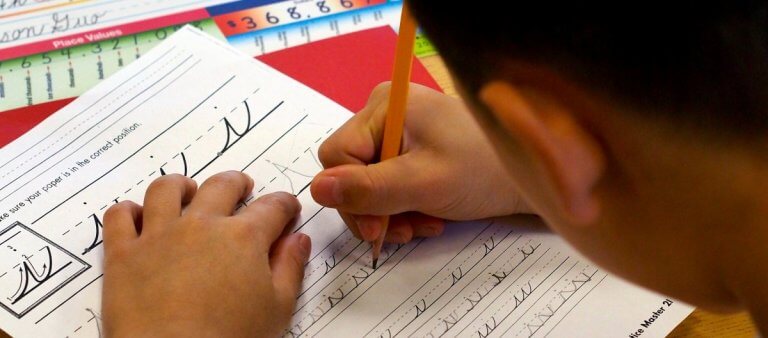
American schools are slowly reintroducing cursive instruction. From Illinois to Ohio, schools are now offering at least one class on the forgotten art, which was dropped from the Common Core State Standards in 2010.
The Standards, which detail what K-12 students should know of the English language, arts and mathematics at each school grade, deemed that students should learn how to use a keyboard and write in print instead.
Cursive’s resurgence may seem anachronistic in the keyboard age. More than just another skill to learn, it’s tied to loaded notions of American values and identity. Anne Trubek, author of The History and Uncertain Future of Handwriting, told the New York Times that the teaching of cursive a decade ago was aimed at developing a civilised, well-mannered population.
“People were upset about the idea that you might not seem educated if you didn’t know cursive,” she said.
Lately, however, it’s become more to do with “convention, tradition, conservatism,” she said. To be American is to be able to read and write cursive, so it goes. Several Republican lawmakers behind the campaign to revive cursive teaching say in is necessary for the reading of historical texts like the Constitution and the Declaration of Independence.
Students: When you write with a pen or pencil, do you print, write in cursive or alternate between the two? Do you have a signature that you use when you sign forms? If you don’t write in cursive, is this a skill you wish you had?https://t.co/kctoHLJ3v8
— NYT Learning Network (@NYTimesLearning) April 15, 2019
Whatever its symbolism, the pen is mightier than the keyboard, according to research. Cursive writing – where one writes with a pen without raising the hand between each character – gives students important cognitive benefits. How we produce a text is just as important as quality of the text.
Experts on writing say this is because handwriting ignites several cognitive processes.
“Handwriting is a complex task which requires various skills – feeling the pen and paper, moving the writing implement, and directing movement by thought,” says Edouard Gentaz, Professor of Developmental Psychology at the University of Geneva.
“Children take several years to master this precise motor exercise: you need to hold the scripting tool firmly while moving it in such a way as to leave a different mark for each letter.”
Source: Giphy
It bolsters creativity, too. Claire Bustarret, a manuscript specialist at the Maurice Halbwachs Research Centre in Paris told The Guardian: “Word-processing is a normative, standardised tool…Obviously, you can change the page layout and switch fonts, but you cannot invent a form not foreseen by the software.
“Paper allows much greater graphic freedom: you can write on either side, keep to set margins or not, superimpose lines or distort them. There is nothing to make you follow a set pattern. It has three dimensions too, so it can be folded, cut out, stapled or glued.”
Let’s not forget the “record” of our creative stages too, ie. all the markings, errors and additions we scribble on paper.
Other research claims students also get the following suite of benefits: better comprehension of a subject, improved letter recognition, engagement of both cerebral hemispheres, and more.
Critics and educators are not so quick to agree. Typing “allows us to go faster, not because we want everything faster in our hyped-up age, but for the opposite reason: we want more time to think,” according to Anne Trubek, former Associate Professor of Rhetoric and Composition at Oberlin College in Ohio.
There is evidence that cursive’s comeback campaign could be motivated by profit rather than aims for academic betterment.
Kate Gladstone, of the Handwriting Repairwoman, found that in states like North and South Carolina, the research used by lawmakers to push for cursive instruction in school was done by Zaner-Bloser Publishing, a for-profit company that creates instructional materials to teach handwriting. The company denies lobbying but acknowledged it provides lawmakers with research.
Liked this? Then you’ll love…
How to improve your handwriting, no robots required
Art classes improve students’ discipline, writing and compassion







